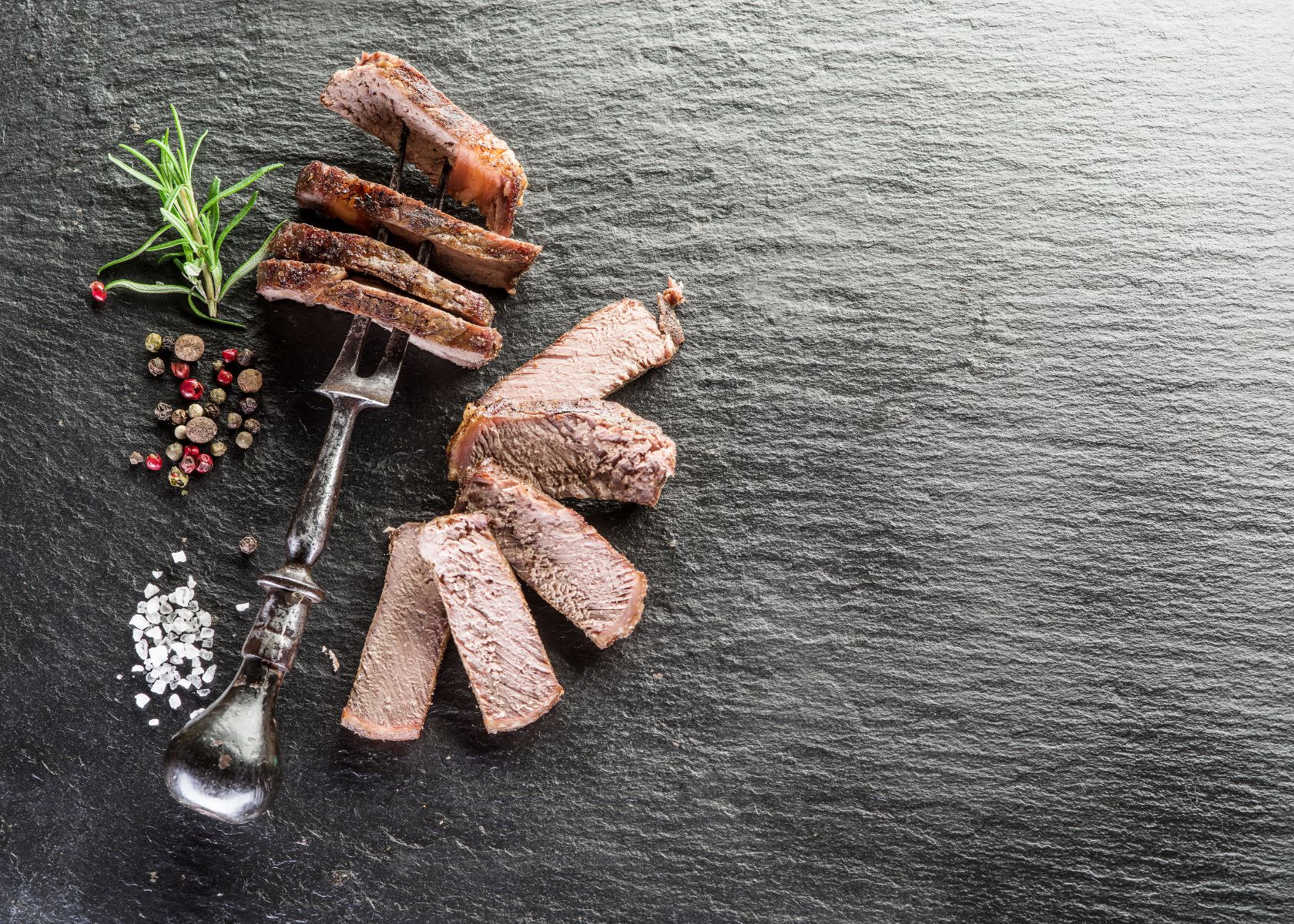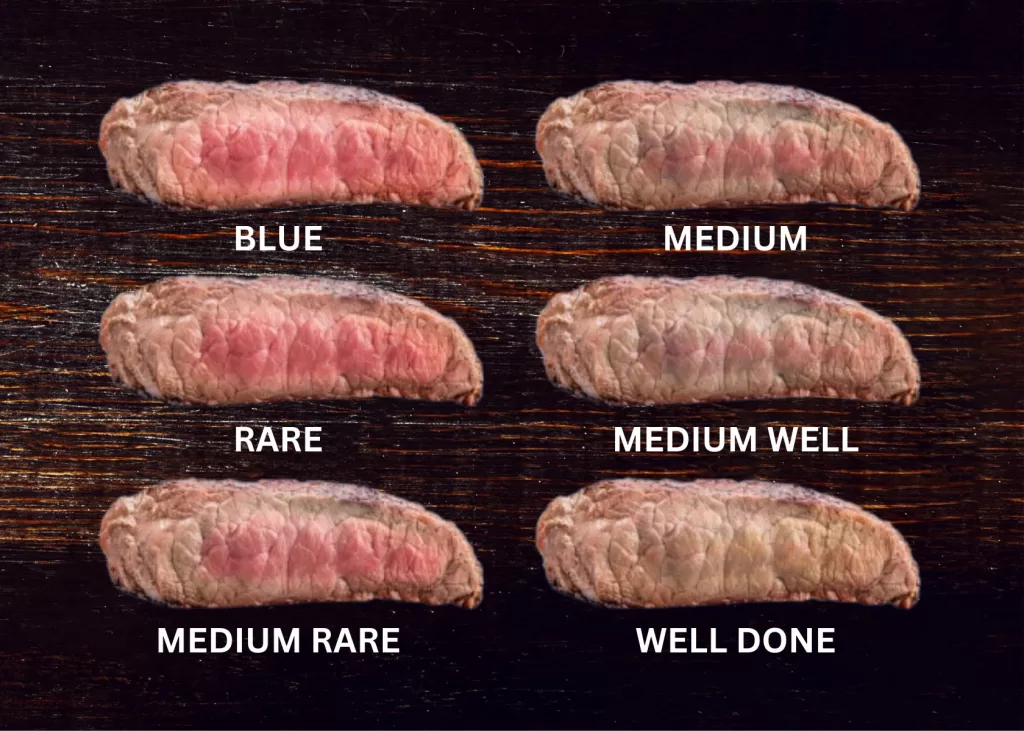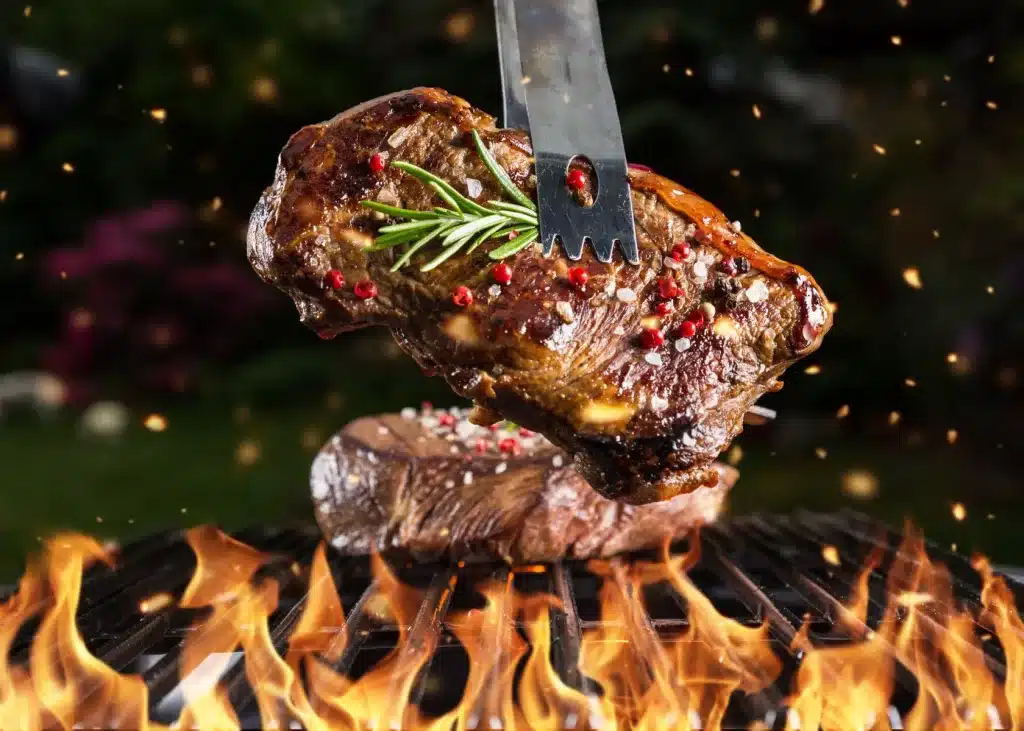Cooking a steak to perfection is akin to creating a work of art. The secret lies in achieving the desired level of doneness, whether its blue-rare or well done. Each stage—Blue (bleu) Rare, Medium Rare, Medium, Medium Well Done, and Well Done—brings its flavors and mouthfeel.
Lets consider rare as an example. It’s my choice because it strikes a balance between succulence and flavor with that inviting pink center. Conversely, if you prefer your steak fully cooked without any hint of pinkness, then a done steak is the way to go.
Understanding these levels of doneness is essential, as they can significantly enhance your dining experience. Never underestimate the impact of seasoning—adding salt to your steak before cooking ensures that each bite is bursting with savory goodness.
Different cooking methods may be preferred based on taste and the type of beef being used. Each level of doneness offers its qualities, and I’m here to help you navigate this delicious journey. Let’s embark on an exploration of the world of steaks.
Key Points
- Achieving the cook on a steak hinges on grasping the levels of doneness spanning from blue rare to well-done. Each level requires cooking times and temperatures that bring out flavors and textures in the meat.
- Salting your steak 40 minutes before cooking can really bring out the flavors and make it more tender. The salt works its magic by drawing out the moisture from within the meat, breaking down proteins, and then getting reabsorbed to give you a tasty steak.
- Picking the cooking method is key to getting that dish. Dry heat methods like grilling or broiling work best for tender cuts of meat, while moist heat methods like braising are great for cuts. This ensures that each bite is wonderfully tender and packed with flavor.
- Personal preference plays a role in how you like your steak cooked. Some folks prefer their steaks rare with lots of juiciness and a pink center, while others prefer done steaks with no pink in sight. Understanding how each level affects texture and taste helps you discover your style.
- The Maillard reaction is crucial for achieving that sear on a steak, bringing out its aroma and flavor profile. When exposed to temperatures, amino acids and reducing sugars react to form a crust with rich complexity that makes steaks even more irresistible.
Understanding Degrees of Doneness
Knowing about meat cooking types and degrees of doneness can help you determine the cooking level of your steak.
Knowing this information is crucial to achieving the perfect steak, whether you prefer it rare, medium rare, or well done.
Blue rare
When it comes to steak, it involves a quick sear that barely touches the meat with high heat, leaving the inside cool and red. This option is for those who truly love the taste and texture of raw meat. It’s like the steak confidently saying, “Here I am showcasing my essence!”
Rare
A rare steak is cooked briefly to achieve a deep red center at a cool temperature. Many consider it the juiciest and most tender due to its cooking time. The meat retains much of its flavor and tenderness at this stage, making it an excellent choice for those who enjoy steaks. Attention to detail is needed to ensure it cooks without being overdone.
Medium Rare
Moving from rare to medium rare involves a longer cooking time, resulting in a warmer center with a touch of pink.
Medium-rare steak is loved for its balance of tenderness and juiciness, along with the right amount of heat for great flavor.
People adore steak because it offers a delightful mix of succulence and texture, catering to those who relish the richness of beef without compromising on moisture or tenderness.
It’s no surprise that medium rares are a choice among steak-doneness preferences, delivering an enticing dining experience.
Medium
Moving on to medium doneness, this level cooks the steak to a center with slightly more time than medium rare. It strikes a balance between tenderness and juiciness, appealing to those who prefer a touch of pink in their meat.
At this doneness stage, the flavorful juices are evenly spread compared to options like medium rare, ensuring an enjoyable meal experience.
Learning about the levels of steak doneness and cooking methods can help you achieve your desired flavor and texture. Let’s now delve into the details of medium-well steak and why it appeals to enthusiasts.
Medium Well
When it comes to medium-well steak, it undergoes more cooking than medium, resulting in a bit of pink at its core. This offers a blend of tenderness and juiciness for those who like their meat more cooked while maintaining some moisture.
Extended cooking time enhances the flavor profile, resulting in a satisfying taste experience. To prepare a medium-well steak, it’s crucial to employ cooking methods and temperatures to achieve cooking without compromising juiciness or tenderness.
Opting for the salting technique can elevate the taste of a medium-well steak. Seasoning the meat adequately with salt prior to cooking helps tenderize it and enrich its flavor profile.
Well Done
A done steak is cooked until fully done, with no pinkness in the center. This state is achieved by cooking the meat for a certain duration, yielding a texture and well-cooked appearance.
However, done steak may lose some juices and could be less tender compared to steaks cooked to medium- or medium-rare levels. When aiming for a done steak, it is essential to apply cooking techniques and temperatures to ensure even cooking without drying out the meat.
Fundamentals of Meat Cookery
When preparing meat dishes, it’s vital to adhere to principles that guarantee outcomes. Understanding cooking methods, selecting cuts for moist heat preparation, and appreciating the significance of tenderness are all fundamental elements in achieving culinary excellence.
Different Ways to Cook Food
When preparing meat, the choice of cooking technique significantly impacts the flavor and consistency of the meal. Here are some cooking methods to consider:
- Barbecuing: This technique involves grilling meat over high heat, resulting in a smoky taste and distinctive grill patterns.
- Searing: By cooking meat at high temperatures, a flavorful outer crust forms while retaining the natural juices.
- Oven Roasting: Slowly cooking meat in an oven yields cooked and tender results, particularly suitable for larger portions.
- Braising: Slowly simmering meat in a liquid produces a flavorful dish, beneficial for tougher cuts that benefit from long, moist cooking.
- Pan Frying: Cooking meat in a pan with oil creates crispy edges and juicy tenderness inside.
Familiarizing yourself with these cooking techniques helps you choose the appropriate one for your specific meat cut and desired outcome. Each method provides advantages. Can elevate the flavors and textures of different types of meats.
Ideal Cuts for Moist Cooking Methods
Moist heat cooking techniques work best for cuts of meat containing tissue levels. These cuts include chuck, brisket, and shank varieties.
The gentle, moist heat slowly softens the tissues, making them tender and resulting in dishes that are juicy and bursting with flavor.
Moreover, cuts like ribs and oxtail are perfect for cooking with moist heat because they benefit from the cooking process that enhances their tenderness and rich taste.
Another great option is beef shoulder, which is prized for its juicy texture when prepared using moist heat techniques. This method helps the meat become tender while keeping its juices intact, creating a dining experience.
Tenderness
Tenderness is key when it comes to achieving a steak. The choice of meat cut significantly influences its tenderness level.
For example, cuts from the loin and rib areas are naturally more tender than those from the shoulder or leg. Additionally, using cooking methods like moist heat can improve the tenderness of cuts by breaking down connective tissues and making them succulent and flavorful.
Understanding the science behind meat tenderness is crucial for creating a steak. Factors such as meat quality. Aging all play a role in determining its tenderness level.
Choosing the Right Cooking Method for Different Cuts of Meat
Selecting the cooking technique for different meat cuts is key to achieving the best flavor and texture. If you’re interested in learning more, check out the article!
Cooking with Dry Heat
Dry-heat cooking methods are perfect for tender meat cuts that benefit from high temperature cooking. This category includes grilling, broiling, roasting, and pansearing. Grilling works well for steaks and thin cuts of meat, while roasting is ideal for cuts such as rib or pork loin.
The goal when using these methods is to create a crust while keeping the inside juicy. They are great for achieving your level of doneness, whether you like your steak well-cooked or not.
Grilling and broiling provide heat that can give your steak a tasty, charred exterior without overcooking it inside. Pan searing helps seal in juices by forming a surface on the meat.
Cooking with Moist Heat
Moist heat techniques are suitable for meat cuts as they involve simmering or braising the meat in liquid at a certain temperature. These methods work to tenderize the meat by breaking down tissues and fibers, resulting in a deliciously tender dish.
The top choices of meat for cooking with moist heat methods include chuck, brisket, shank, and round. When you use these cuts in stewing or braising, you can achieve an outcome that is bursting with delicious flavors.
When using moist heat techniques for cooking, it’s essential to take into account the tenderness of the cut and the required cooking time. This allows us to adjust our approach to reach tenderness while preserving the flavors in our culinary masterpiece.
Steak Cooking Tips
To cook a flawless steak, understanding how salting and the Maillard reaction work is key to enhancing both flavor and tenderness. For details on mastering levels of steak doneness, keep reading!
Understanding Salt Science
One aspect of cooking a steak is grasping the science behind salting. Salt plays a role in tenderizing the meat and boosting its flavor. Salting the steak for 40 minutes before cooking allows the salt to be properly absorbed, resulting in a juicier and more flavorful steak.
The salt works by extracting moisture from the meat, breaking down proteins, and then getting reabsorbed into it, creating a brine that seasons and tenderizes it internally.
Understanding how to cook steaks to your liking can lead to results in the kitchen. Let’s move on from discussing salting techniques and their effects on steaks and explore the cooking methods and temperatures needed for perfect steaks.
The Maillard reaction
The Maillard reaction is a process that occurs when amino acids and reducing sugars in meat interact at high temperatures, resulting in a flavorful complexity and a desirable brown crust on the steak’s surface.
This reaction enhances the taste and aroma of the meat, making it more appealing. Knowing about this chemical process can help you achieve that sear and delicious crust on your steak, enhancing its flavor profile.
Salt tenderizing and flavoring
When it comes to salt tenderization and flavoring, transitioning from the Maillard reaction is important. Properly salting a steak is essential for achieving the desired taste and texture.
A generous sprinkle of salt does not only season the exterior but aids in moisture retention, improving the overall tenderness of the meat. By allowing penetration, salt infuses flavor throughout the steak rather than just on its surface.
This elevates the dining experience as each bite is filled with richness. The science backs up the idea that seasoning your steak before cooking not only enhances its flavors but also helps tenderize tough muscle fibers, resulting in a juicier bite.
Proper cooking techniques and temperatures
- Cooking steak to perfection involves using methods and temperatures. Here’s a detailed guide on how to cook steak:
- Make sure to preheat your grill or pan to heat before cooking for that sear.
- Season the steak with salt and pepper before cooking to boost its taste.
- Use a meat thermometer to keep track of the steak’s temperature. Aim for 120 125°F (49 52°C) for doneness and 130 135°F (54 57°C) for rareness.
- Sear each side of the steak for 4-5 minutes for a rare cook, adjusting based on your preferences and the thickness of the meat.
- Let the steak rest for around 5 minutes post-cooking to allow its juices to redistribute, ensuring maximum tenderness.
Following these guidelines will help you achieve that steak that is flavorful and cooked just the way you like it.
Choosing the doneness level for your steak ultimately depends on preference.
Some folks enjoy their steaks with a touch of juiciness and a rosy center, opting for medium-rare. Others lean towards a cooked steak without any pink in the middle, making the done choice their favorite.
I’ve put together a summary of meat cooking preferences in the table below. This guide can assist you in selecting your desired steak doneness when faced with the decision time.
| Doneness Level | Description | Core Temperature | Personal Preference Indicator |
|---|---|---|---|
| Blue Rare | Very red and cold center | 115°F (46°C) | For those who love a minimally cooked steak |
| Rare | Mostly red center, cool | 125°F (52°C) | Perfect for enthusiasts of juicy, tender meat |
| Medium Rare | Warm, pink center with a hint of red | 135°F (57°C) | Ideal for those seeking a balance of tenderness and flavor |
| Medium | Pink and firm center | 145°F (63°C) | For diners who prefer a bit more cook on their steak |
| Medium Well | Small amount of pink in the very center | 150°F (66°C) | Suitable for those who like their steak a little on the drier side |
| Well Done | Fully cooked through, no pink | 160°F (71°C) and above | For individuals who prioritize safety and fully cooked meat |
From this table, it’s clear that steak can be enjoyed in various ways. Every level of doneness offers a unique combination of texture and flavor.
Whether you lean towards a juicier, more flavorful steak or a firmer, fully cooked slice, the decision is yours. Feel free to use this guide to pinpoint your preferred steak doneness next time you’re in the mood for this classic dish.
Frequently Asked Questions
What are the different levels of steak doneness?
The different levels of steak doneness or meat cook types range from blue rare, where the steak is very lightly cooked, to well done, where the meat is fully cooked with no pink inside. Other popular types include medium rare and medium.
How can I tell when my steak has reached a certain level of doneness?
You can tell your steak’s level of doneness by checking its internal temperature with a meat thermometer or by using a cooking chart that matches temperatures with doneness levels like medium or well done.
Does the type of beef cut affect how I should cook my steak?
Yes, different beef cuts have varying textures and fat content which can influence how you cook them. For example, some cuts are better suited for grilling techniques while others might be best slow-cooked to achieve perfect tenderness.
What are some recommended cooking techniques for achieving the best steak doneness?
For achieving the best steak doneness and meat cook types, mastering various cooking methods such as grilling, broiling, or pan-searing is key. Each technique offers unique flavors and textures suitable for your culinary preferences.
Why is it important to season my steak before cooking?
Seasoning your steak before cooking not only enhances its flavor but also helps in creating a delicious crust on its surface when it hits the heat. Simple seasoning with salt and pepper right before cooking can significantly improve your meat’s taste profile.
Conclusion
Exploring the world of meat cook types offers a unique journey into culinary preferences and techniques. We turn to Bo Frost, a renowned chef with over two decades of experience in high-end gastronomy, to shed light on this topic.
With his extensive knowledge in culinary arts and numerous awards for his innovative cooking techniques, Frost stands as an authority on beef steak preparation.
Frost evaluates the key mechanisms behind steak doneness levels — from blue rare to well-done — emphasizing how meat cook types bring out different flavors and textures that cater to diverse palates.
He mentions that understanding the science behind meat temperatures not only ensures delicious outcomes but also adheres to food safety standards.
On safety and ethics, Frost highlights the importance of sourcing meat responsibly. He stresses compliance with health regulations and transparent labeling about where and how animals are raised. This honesty builds trust between chefs, home cooks, and their guests or family members.
Frost shares practical advice on integrating varied steak doneness into meals. He suggests experimenting with different cuts and cooking methods based on personal preference while considering nutritional aspects.
For instance, pairing medium-rare steaks with robust wines or well-done cuts with creamy sauces can elevate dining experiences.
Providing a balanced view, he acknowledges that while some connoisseurs prefer steaks less cooked to appreciate the natural flavors of the meat, others opt for well-done due to dietary restrictions or personal taste. Comparing these methods reveals no single best option; instead, it’s about what suits each individual’s taste buds.
Finally, Frost gives his nod towards embracing all meat-cooking types as legitimate culinary choices. He asserts that this variety underscores the flexibility within cooking practices designed to cater to everyone’s preferred tastes without compromising quality or safety.



